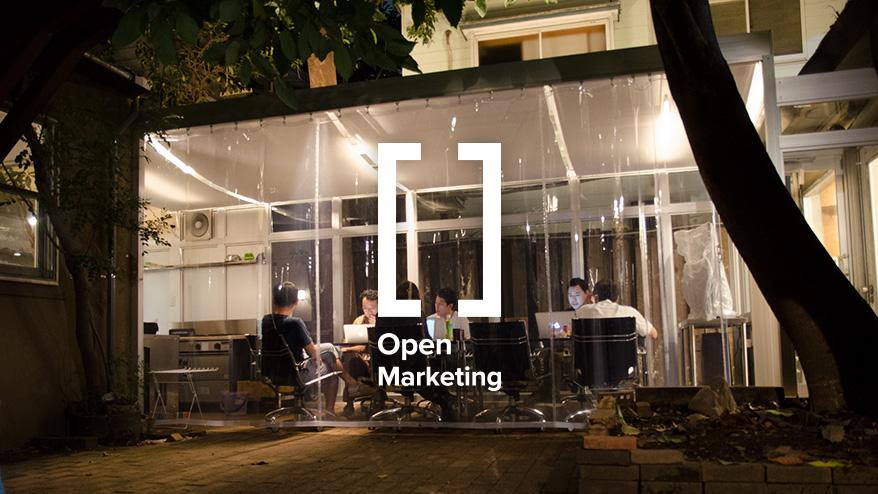みなさん、こんにちは。モノサス代表の林です。
Open Marketing の連載も早くも8回目。
月末がくるのが憂鬱になるくらい必死で書いていますが、
書き進めてゆくうちに、自分自身もこれまで感覚的に語ってきたことが
体系化されてまとまり、自分の仕事の軌跡をたどるような
時間にもなっています。
さて、前回はリピート領域まで話を進め、現代のマーケティング理論が産んだ
落とし穴である、Acquisition 領域と Retention 領域を分けることの弊害について
お話しました。
そのなかで、最も大切なポイントは、
リピートさせるのではなく、離脱させないという考えかたに立つこと
であるとお伝えしました。
リピートさせるという考えかたには、1回目と、2回目以降の取引を
別々に考えるというアプローチが包含されており、
それこそがマーケティング活動の大きなロスになっているのです。
また初回取引の際、
顧客は商品が欲しかったのであって、
あなたの会社の顧客になりにきたのではなく、
この顧客を、自社の顧客へと転換する必要があるとも
お伝えしました。
第8回である今回は、初回取引の顧客をいかにして
自社の顧客へと転換していくかについてお話したいと思います。
気持ちではなく、行動を変える
ここでまずお話しておきたいのは、
「私はこの会社の顧客になった」と顧客に認識してもらうことが
今回の目的であるのですが、顧客の心の中を直接コントロールすることは
不可能であるということです。
自分自身の心や感情ですらコントロールすることが難しいのに、
他人の、しかも多数の顧客の心の中を直接コントロールすることが
難しいのは、少し考えてみればすぐわかることです。
しかし、ここで私は直接という言葉を使っています。
つまり、直接でなく、間接的であればコントロールすることが
ある程度可能であると考えています。
仏教用語に、身心一如(しんじんいちにょ)という言葉があります。
肉体と精神は一体のものであるという意味です。
(心身一如とも書きますが、私は身心一如であると解釈しています)
仏教や宗教を研究したことがないので、専門的な解説をすることはできませんが、
この言葉を知ったときに、それまで悩んでいたことがスッと解決しました。
私なりの解釈ですが、仏教は悟りをひらくことを最終目的として
修行を重ねていきますが、悟りをひらくとは、肉体ではなく、精神の状態です。
しかし、精神を直接鍛えることは難しく、
そのために、早朝に起き、決められた服を着、決められた食事を摂り、
掃除をし、座禅を組み、といったように、
1日のすべての行動を正します。
行動とは、動いて行うことですから、やはり肉体に属するものです。
つまり、肉体に属する行動を正すことで、
精神を鍛え、それを繰り返すことで、
ひいては悟りの境地にいたることがことができるということなのだと思います。
このことから私は、身心一如を
よりマーケティングでも活用しやすいように、
行動と感情は一体のものであると読みかえています。
これはみなさんもご自身で、すぐに体感していただくことができます。
例えば、なにか悲しいことがあって涙が出てしまったとき、
鏡の前で無理やりニコっと笑ってみてください。
すると、よほどの悲しみでない限り
涙がすっと止まるはずです。
そして、悲しい気持ちも少しおさまってくるはずです。
きっと全く笑う気持ちにはなれないでしょうが、
だまされたと思ってやってみてください。
ほかにも、やってみるまでもなくみなさんもご存知の事象が
いくつもあると思います。
落ち込んでいる人は下を向き、背が曲がる。
喜びと自信に溢れる人は上を向き、胸を張る。
過去の記憶を辿っている人は、左上を見る。
未来のことを想像している人は、右上を見る。
また、スポーツの世界でもこのことは広く実践されています。
スポーツのパフォーマンスは技術や体力、体調などに
大きく左右される側面もありますが、競り合ったとき
最終的に勝敗を分けるのは精神面です。
これらを知っているトッププロは自らのモチベーションをかきたてたり、
逆にモチベーションの低下を防ぐためのルーティーンや、生活習慣を必ず持っています。
試合の前に聴く曲を決めているフィギュアスケート選手、
試合の前に食べるものを決めているマラソン選手、
打席に入ったときの動きがルーティーン化されている野球選手など、
例をあげればきりがありません。
このように、感情と行動は高度に連携しあっていて、
まるで一体のように相互に影響しあっているのです。
「私はこの会社の顧客になった」と思ってもらうために
感情面を直接変化させることは、ほぼ不可能です。
しかし、「私はこの会社の顧客になった」と思ったのと
同じ行動を取ってもらうことができさえすれば、
その内面に変化を起こすことが可能なのです。
少なくとも目指す心理状態になってもらえる確率は
確実に向上します。
初回取引時が重要な理由
このとき重要なのが、前回お話した
初回取引が、最大にして、唯一の固定客化のチャンス
というポイントです。
なぜなら、初回取引の前後が最も顧客のモチベーションが高いからです。
モチベーションが高いというのは、もう少し具体的に言うと
その商品・サービスに対するマインドシェアが高いということです。
新しい時計が欲しいとき、新しいカメラが欲しいとき、
新しい車が欲しいとき、新しい携帯電話が欲しいとき・・・
そういったとき、人は多くのマインドシェアを購買に対して割きます。
一方で、購買から時間が経つにつれてマインドシェアは低下していきます。
一般的に、購買単価が高く、購買頻度が低いものほど
マインドシェアの低下には時間がかかり、
購買単価が低く、購買頻度が高いものほど
マインドシェアの低下が速い傾向にあります。
例えば家のように、一生に一度と言われるような大きな買い物は
最低でも1年は「新築」と考えるでしょうし、
歯ブラシのような日常的に購買するものは
一度使ってしまえば興味が冷めてしまうものです。
他の要素として、その人がそもそも特殊なマインドシェアを持っている
ケースはありますが、(かなり確率は低いですが、歯ブラシへのマインドシェアが高い等)
今日の主題から逸れるので詳述は控えます。
いずれにしてもマインドシェアが一度下がってしまうと、
再びマインドシェアを上げることは非常に困難です。
そして、マインドシェアが下がった顧客に
施策を実行しても効果はほとんど期待できません。
なぜなら、あなたの商品・サービスにすでに興味を失っているからです。
マインドシェアが高い状態のときに
固定客のような行動をとってもらうための施策を実施することは、
成功のための生命線なのです。
固定客に共通する行動とは、なにか
では、固定客の特徴とはどのようなものでしょうか。
最も分かりやすいのは固定客の分析で用いられる
RFM 分析の指標です。
RFM 分析とは、
- Recency(最終購買からの経過期間)
- Frequency(購買頻度)
- Monetary (使用金額)
の3つの要素を元に分析する手法のことですが、
固定客はこの3つの指標の数値が高いことが特徴です。
しかし、様々なプロジェクトで分析をしてきた中で、
固定客、ひいては上位顧客と呼ばれる顧客は、
購買頻度が高いことが最も重要な特徴であることを突き止めました。
購買頻度が高ければ直近の購買も起こりやすくなりますし、
使用金額もある程度比例して伸びていきます。
多くの企業では使用金額の多い顧客を上位顧客とする傾向が
あるのではないかと思います。
これは正しい部分もありますが、
見逃している点がいくつかあります。
それは、
-
最初の買い物でドカンと買い物をして二度とこないような
使用金額だけが大きい顧客が現実に多く存在する -
リピート性の高い商品、サービスの場合、使用金額が上がりすぎると
顧客の財布が追いつかなくなり、離脱する傾向がある
といった点です。
前者はわかりやすいと思いますが、後者については少し説明が必要だと思います。
それは、例えば月の可処分所得が30,000円(お小遣いと読みかえてもかまいません)
の男性顧客が、一回あたりの取引単価が10,000円のサービスを、
週1回程度の利用頻度で利用するようになったような場合です。
可処分所得の全てをそれにあててもまかないきれませんので、
当然ながら早期に離脱してしまいます。
携帯電話料金が可処分所得に対して大きすぎるような場合も
コストを下げるためにプランをダウングレードしたり、解約するのと
同じことです。
つまりは払いきれなくなってやめてしまうということです。
このように、使用金額を伸ばそうとする施策に偏ってしまうと、
実は顧客を追い詰め、離脱を促進してしまう可能性もあるので
要注意です。
私が結論として出したのは、
固定客とは、購買頻度の高い顧客であるということです。
つまり、実にシンプルに
顧客に頻度高く購買するという行動を取らせることができれば、
「私はこの企業の顧客である」という意識を持たせることができるということです。
あまりに単純な話だと思われるかもしれませんが、
そのための施策を初回取引前後で実施しきる必要があるのと、
実際に購買頻度を確実にあげるためには、綿密な施策設計と
実行力が必要です。
今回施策の具体的なところまでお話しするつもりでしたが、
解説が長くなってしまったので、次回こそ具体的な施策について
お話しさせていただきます。
ではまた来月お会いしましょう。

